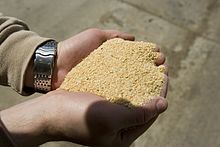Soy protein
Soy protein refers to the proteins in soybeans and is an umbrella term for various products made from soy meal that contain a high proportion of protein. Examples are de-oiled soy flour, soy protein concentrate, and soy protein isolate. Soy is an important source of protein in animal feed and food.
Manufacturing
Soy protein is obtained from soy meal that is obtained from soybean oil production. For use as food or in animal feed, especially for monogastric animals , heat treatment is necessary in order to reduce the content of anti-nutrient ingredients. There are various methods that use direct heat, steam or additional pressure. For example, textured soy can be produced after the treatment .
For the production of soy protein concentrates with protein contents of approx. 65-72%, soluble parts (soluble carbohydrates, flavorings and aromas) are extracted from soy flakes using a 60% alcohol-water mixture, while the poorly soluble proteins remain.
Soy protein isolates with up to 90% protein can be produced in a two-step process. In the first step, soluble components are separated off in water in a slightly alkaline medium (pH 8-9). In the second step, the pH value is reduced to 4.8 (the mean isoelectric point of the mixture) and the proteins are precipitated. For work-up, it is centrifuged and the residue is washed and dried.
Composition and Physiology
Soy proteins can be roughly divided into two classes: globulins and albumins . On closer analysis, different protein fractions can be distinguished based on their sedimentation coefficients :
- 11S fraction (glycinin) 35%
- 7S fraction (conglycinin) 30%
- 2S fraction 20%
- 15S fraction 15%
The most common amino acid building blocks in soy protein are glutamic acid and aspartic acid . Soy protein is rich in hydrophilic amino acids, which means that the water solubility for a vegetable protein is quite high. Due to the composition of the essential amino acids, it is physiologically valuable, even if - as with legumes in general - there is a slight deficit in sulfur-containing amino acids. It is an important vegetable protein source in vegetarian and vegan diets.
The glycinin in soy protein is a food allergen that is responsible for soy allergies .
use
Use in feed and food
Soy protein uses as food for humans and feed for animals is the most important application.
In addition to direct use as food and feed, there are numerous other possible uses for soy protein products. They are used to improve the quality of workmanship, for example for meat products, children's foods or pasta and baked goods, and to improve the protein supply. Glutamate and condiments can also be obtained from soy protein .
In the past, soy protein has been tried and actually used in many technical applications. Due to its composition of approx. 50% protein and 50% glucose, the extraction meal has good prerequisites as a composite material and can be crosslinked with formaldehyde . This material was tested by Henry Ford in particular in the automotive industry and used in a wide variety of areas - interior parts, technical components and exterior parts. The development culminated in the soybean car presented in 1941 , in which fourteen external components were made of this material.
Soy protein can also be used as a low-emission binding agent for gluing wood, such as wood fiber boards .
Currently only 0.5% of soy protein is used technically, the main application being paper coating. Due to the stickiness of soy protein, pigments and fillers can be bound, which give paper a glossy white surface. Soy protein has also been tried in all common plastics processing methods, but the products are very brittle, which means that plasticizers are required.
Research is currently being carried out into the production of plastic films from soy protein isolate, especially for packaging. These would be bio-based , biodegradable and, through the addition of various additives, can have additional antibacterial and lotus-like properties.
Individual evidence
- ↑ a b c d e f g Oliver Türk: Material use of renewable raw materials . 1st edition. Springer Vieweg, Wiesbaden 2014, ISBN 978-3-8348-1763-1 , p. 121-130 .
- ↑ Stefan Thurner, Robert Zeindl & Ludwig Asam: Comparison of process technology for soy processing . In: LfL - Bavarian State Institute for Agriculture (Hrsg.): Agricultural research has a future - Scientific conference of the LfL . 2013, ISSN 1611-4159 , p. 63-72 .
- ↑ a b L. Schutte: Technical problems and solutions in the production of soy proteins . In: fats, soaps, paints . tape 6 , 1977, pp. 230-234 .
- ↑ a b c Entry on soybean products. In: Römpp Online . Georg Thieme Verlag, accessed on October 14, 2019.
- ↑ Reinhard Matissek: Intolerance reactions / allergies to food . In: Reinhard Matissek & Werner Baltes (eds.): Food chemistry . 8th edition. Springer Spectrum, Berlin 2016, ISBN 978-3-662-47111-1 , chap. 13 , p. 395-409 .
- ↑ Shikha Rani & Rakesh Kumar: A Review on Material and Antimicrobial Properties of Soy Protein Isolate Film . In: Journal of Polymers and the Environment . tape 27 , 2019, p. 1613-1628 , doi : 10.1007 / s10924-019-01456-5 .




